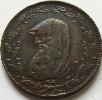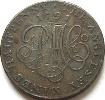Reprising this post from when I enjoyed George Selgin’s Good Money: Birmingham Button Makers, the Royal Mint, and the Beginnings of Modern Coinage, 1775-1821 (University of Michigan Press, 2008).

Come the Industrial Revolution, the number of wage earners rose dramatically, increasing dramatically the need for small denomination coins to pay them and for them to pay for their own purchases. Yet the Royal Mint was slow to respond, continuing to focus its efforts on large denomination gold and silver coinage and paper. So some desperate businesses, mining companies and large manufacturers first, decided to issue their own coinage. An example is the Anglesey Mining Company’s “Druid” halfpenny, pictured here.
Selgin comments on the importance of this development:

“Had it not been for commercial coins, Great Britain’s Industrial Revolution, instead of accelerating to a gallop as the nineteenth century approached, might have slowed to a saunter, if not a snail’s pace, for until these coins made their appearance, manufacturers had to struggle to pay their workers, while retailers had to struggle to make change” (p. 2).
Selgin’s history also has implications for the monopoly status of government money in the modern world.
And of course there’s the important historical question: Why a druid?
Related: My “You Should Love Money” [Open College podcast]